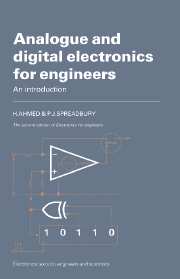Book contents
- Frontmatter
- Contents
- Preface to the second edition
- Preface to the first edition
- 1 Principles of amplifiers
- 2 The p–n junction and the field-effect transistor
- 3 The bipolar transistor
- 4 Operational amplifiers and linear integrated circuits
- 5 Negative feedback
- 6 Positive feedback and oscillators
- 7 Digital fundamentals
- 8 Digital circuits and applications
- Appendix A A list of useful textbooks
- Appendix B Device data and characteristics
- Answers to problems
- Index
8 - Digital circuits and applications
Published online by Cambridge University Press: 05 June 2012
- Frontmatter
- Contents
- Preface to the second edition
- Preface to the first edition
- 1 Principles of amplifiers
- 2 The p–n junction and the field-effect transistor
- 3 The bipolar transistor
- 4 Operational amplifiers and linear integrated circuits
- 5 Negative feedback
- 6 Positive feedback and oscillators
- 7 Digital fundamentals
- 8 Digital circuits and applications
- Appendix A A list of useful textbooks
- Appendix B Device data and characteristics
- Answers to problems
- Index
Summary
Introduction
A simple memory element, made of two inverting gates and also called a bistable circuit, leads to applications such as switch debounce circuits and counters are made of memory elements suitably connected. A counter, apart from its clear application in counting events, data logging and frequency metering, can lead to a powerful way of converting analogue signals into a digital code. This is analogue to digital conversion (ADC) and is a useful ‘interface’ in applying digital circuits to the wide field of measurements.
The memory, or bistable circuit, suitably connected, also forms accumulators and registers on which a computer does its arithmetic. In this chapter, the principles are explained but, for details, the reader is referred to texts on microcomputing or computer science. One important application of a register is to convert a many-bit code into a voltage waveform suitable for passing down a single pair of wires as a cheap form of communication: this is called parallel to serial conversion. A register can also be used to form random signals which can be useful test signals or can simulate noise.
All these applications build on the basic knowledge of gates, Boolean algebra, and the basic memory element.
Bistable circuit (S–R type, latch, J–K, M–S and clocked types)
The bistable circuit described in § 7.9 was called a Set–Reset (S–R) bistable. To understand its mode of operation and to see it in an elegant and useful application as a ‘latch’, consider the circuit shown in fig. 8.1 (a).
- Type
- Chapter
- Information
- Analogue and Digital Electronics for EngineersAn Introduction, pp. 239 - 270Publisher: Cambridge University PressPrint publication year: 1984

